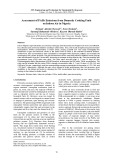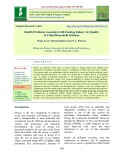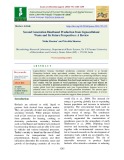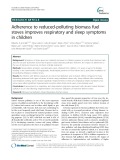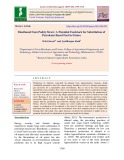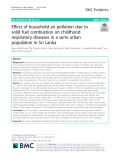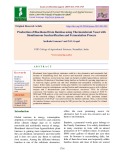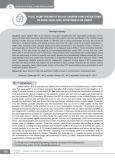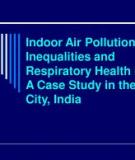
Biomass fuel pollution
-
Due to Nigeria’s high electricity cost, biomass fuels (gas and kerosene) are thought to be more cost-effective, less stressful, and commonly utilized in cooking in urban areas. Thus, this results in higher polycyclic-aromatichydrocarbons (PAHs) concentrations in indoor areas, posing a health risk.
 9p
9p  vispyker
vispyker
 16-11-2022
16-11-2022
 5
5
 1
1
 Download
Download
-
In addition to its effects on air quality, stubble burning also affects soil fertility (through the destruction of its nutrients), economic development and climate. The crop stubbles (if managed properly) could provide immense economic benefits to the farmers and protect the environment from the severe pollution. Some of the alternative management practices include the incorporation of the stubble into the soil, use of stubble as fuel in power plants, use as raw material for pulp and paper industries, or as biomass for biofuel production.
 12p
12p  thebadguys
thebadguys
 15-01-2022
15-01-2022
 10
10
 0
0
 Download
Download
-
Indoor air pollution which poses a critical threat to human health with ambient and household air pollution through exposure to pollutants in urban and rural areas in India. The present study was undertaken with the objective to assess the health problems faced by tribal household kitchens. The study was carried out in Udaipur district of Rajasthan state.
 8p
8p  trinhthamhodang1216
trinhthamhodang1216
 19-11-2020
19-11-2020
 12
12
 1
1
 Download
Download
-
Lignocellulosic biomass bioethanol production, commonly referred to as Second Generation biofuels, using agricultural residues, forest residues, energy feedstocks, municipalities, and other waste crop solids is considered as a promising alternative energy source in order to minimize reliance on limited fossil sources, greenhouse gas emissions, and environmental pollutions. Bioethanol from food based materials may lead to „„food vs fuel” conflict with the increase of world population.
 6p
6p  angicungduoc4
angicungduoc4
 26-04-2020
26-04-2020
 19
19
 0
0
 Download
Download
-
The demand for energy is increasing constantly with the increasing population of the world, and the major source of energy (oil and gas) is limited. Fossil fuels are the major source for energy. The excess use of these fuels will lead to serious environmental issues like global warming and air pollution. Since the fossil fuels are getting depleted day by day, it is the high time to convert biomass wastes such as sawdust, rice husk etc., to useful biomass briquettes which will be the substitute for some of the fossil fuels.
 8p
8p  trinhthamhodang4
trinhthamhodang4
 22-03-2020
22-03-2020
 25
25
 1
1
 Download
Download
-
Symptoms of sleep apnea are markedly increased in children exposed to smoke from biomass fuels and are reduced by kitchen stoves that improve indoor biomass pollution. However, the impact of adherence to the use of improved stoves has not been critically examined.
 5p
5p  vinatri2711
vinatri2711
 29-02-2020
29-02-2020
 7
7
 0
0
 Download
Download
-
Production of biofuels, especially bio-ethanol from lignocellulosic biomass, holds remarkable potential to meet the current energy demand as well as to mitigate greenhouse gas emissions for a sustainable clean environment. Rice is one of the most important agricultural crops in India. Rice straw is an important residue which is generated in large amount in India. Every kilogram of grain harvesting is accompanied by the production of rice straw to a tune of 1.0–1.5 kg. Major proportion of the rice straw is burnt in the field itself.
 8p
8p  cothumenhmong3
cothumenhmong3
 22-02-2020
22-02-2020
 14
14
 0
0
 Download
Download
-
Household air pollution from combustion of solid fuels for cooking and space heating is one of the most important risk factors of the global burden of disease. This study was aimed to determine the association between household air pollution due to combustion of biomass fuel in Sri Lankan households and self-reported respiratory symptoms in children under 5 years.
 12p
12p  virome2711
virome2711
 13-01-2020
13-01-2020
 16
16
 0
0
 Download
Download
-
Bioethanol from lignocellulosic substrates could be a key alternative and sustainable fuel because of diminishing fossil fuel reserves and increased concerns over environmental pollution. Therefore, recent focus has made on cheaply available lignocellulosic substrate like bamboo. Production of bioethanol using bamboo as feedstock is gaining importance as of relatively higher growth rate and their abundant and sustainable availability in the tropics.
 10p
10p  kequaidan2
kequaidan2
 13-12-2019
13-12-2019
 19
19
 2
2
 Download
Download
-
Pine waste generated as needle biomass is a serious threat to our environment in Himachal Pradesh in terms of recalcitrance of soil as well as forest fire. According to forest department, 22% of total forest in state is fire prone due to pine trees abundance and their needles being rich in antimicrobial compounds are not degraded down easily in nature.
 13p
13p  cothumenhmong1
cothumenhmong1
 10-12-2019
10-12-2019
 18
18
 0
0
 Download
Download
-
Black Carbon (BC) is an important byproduct resulted from the incomplete combustion of biomass and fossil fuels commonly referred to as soot. BC pollution not only contributes to the climate change but also impacts seriously to human health. In Vietnam, due to strong urbanization process, the number of vehicles is increasing rapidly and vehicle emission becomes the major cause of air quality degradation in major cities, including Hanoi. Several studies have been mentioned to air pollutants in Hanoi.
 5p
5p  vinobita2711
vinobita2711
 31-05-2019
31-05-2019
 9
9
 0
0
 Download
Download
-
The use of alternative fuels to displace coal reduces reliance on fossil fuels, reduces emissions of carbon dioxide (CO2) and other pollutants, and contributes to long-term cost savings for cement plants. Further, due to their high burning temperatures, cement kilns are well-suited for accepting and efficiently utilizing a wide range of wastes that can present a disposal challenge. This report begins with an overview of the types of alternative fuels used in cement kilns, focusing on energy and environmental considerations.
 303p
303p  loixinloi
loixinloi
 08-05-2013
08-05-2013
 90
90
 17
17
 Download
Download
-
Diesel engines, also known as CI engines, possess a wide field of applications as energy converters because of their higher efficiency. However, diesel engines are a major source of NOX and particulate matter (PM) emissions. Because of its importance, five chapters in this book have been devoted to the formulation and control of these pollutants. The world is currently experiencing an oil crisis. Gaseous fuels like natural gas, pure hydrogen gas, biomass-based and coke-based syngas can be considered as alternative fuels for diesel engines.
 278p
278p  bunmang_1
bunmang_1
 03-05-2013
03-05-2013
 130
130
 18
18
 Download
Download
-
More than half of the world's population relies on solid fuels, including biomass fuels (wood, charcoal, dung, agricultural residues) and coal, to meet their basic energy needs. Cooking and heating with solid fuels on open fires or traditional stoves results in high levels of indoor air pollution. Globally, indoor air pollution is responsible for approximately 1.6 million deaths every year. Various interventions are available to reduce indoor air pollution and associated health impacts at the household level.
 8p
8p  doipassword
doipassword
 01-02-2013
01-02-2013
 51
51
 3
3
 Download
Download
-
The major sources of indoor air pollution worldwide include indoor combustion of solid fuels, tobacco smoking, outdoor air pollutants, emissions from construction materials and furnishings, and improper maintenance of ventilation and air conditioning systems. Although some indoor air pollutants, such as environmental tobacco smoke, are of concern globally, profiles of indoor air pollutants and the resulting health risks are generally very different in developed and developing countries.
 15p
15p  doipassword
doipassword
 01-02-2013
01-02-2013
 71
71
 6
6
 Download
Download
-
While wood and to some extent charcoal are the most common solid fuels used in developing countries, China and Mongolia have high household prevalence of coal, especially for heating in open portable space heaters, some with and some without chimney. Mestl et al. (2006), based on data from the China 2000 Population Census, report that about 60 percent of rural households used biomass as primary cooking fuel. Nearly 30 percent of rural households used coal as the primary fuel. Mestl et al model annual average population weighted exposure (PWE) to indoor air pollution by...
 98p
98p  saimatkhauroi
saimatkhauroi
 01-02-2013
01-02-2013
 47
47
 6
6
 Download
Download
CHỦ ĐỀ BẠN MUỐN TÌM








